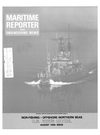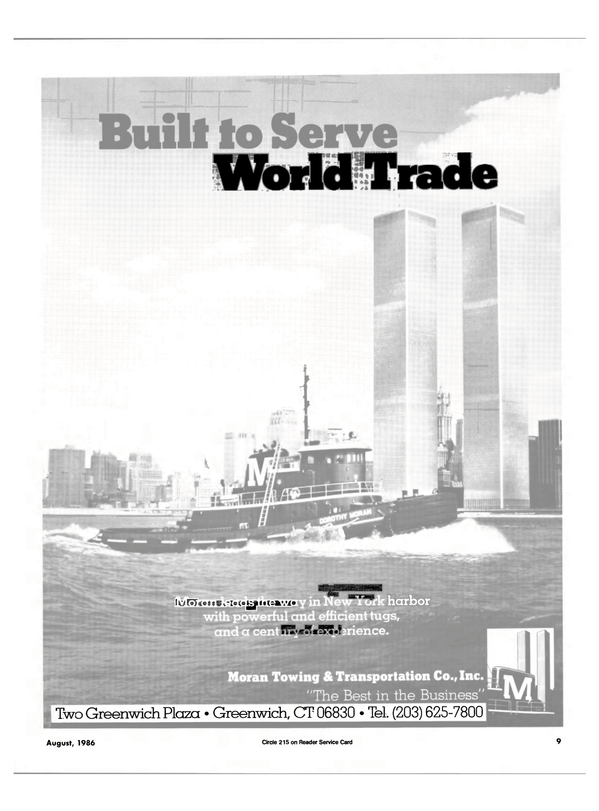
Auxiliary Rescue Salvage Vessel Commissioned At Peterson Shipyard
Several hundred people gathered at the Sturgeon Bay, Wise., shipyard of Peterson Builders, Inc.
(PBI) recently for the commissioning ceremonies of the USS Salvor (ARS-52), one of the most versatile support ships in the U.S. fleet. She is the third of four vessels of this class contracted to PBI by the Navy.
The ship's new commanding officer, Lt. Cdr. Robert A. Reish, USN, assumed command in response to the commissioning directive read by Comdr. John R.
Drucker, USN, Commander of Service Squadron Five. Principal speaker at the ceremony was Vice Adm. Robert L. Walters, USN (Ret.). Other speakers on the occasion were Ellsworth L. Peterson, president of PBI; Rear Adm. Harry K. Fiske, USN, Assistant Deputy Commander for Surface Ships Logistics Management; and Capt.
Thomas J. Kile, USN, Supervisor of Shipbuilding, Conversion and Repair at Sturgeon Bay. Mrs.
Diana Walters, sponsor of the ship at her christening 33 months earlier, was also in attendance.
In addition to being equipped with a recompression chamber to treat diving-related accidents, this new class of salvage ship will replace an older class of rescue vessels with state-of-the-art lift, towing, and diving equipment. The ARS-50 Class has an overall length of 255 feet, beam of 51 feet, draft of 16 feet 7 inches, and displacement of about 3,200 long tons. The Salvor carries a crew of six officers and 85 enlisted personnel; as a non-combatant support vessel, both men and women are eligible to serve in the crew.
Main propulsion is provided by four Caterpillar diesels, each with an output of 1,200 bhp, driving two Bird-Johnson controllable-pitch propellers via GEC reduction gears.
A Brunvoll bow thruster provides enhanced maneuverability. Service speed is 14.5 knots.
The Salvor is equipped with a Raytheon SPS-64 navigational radar fitted with a computerized collision- avoidance system. This unit automatically tracks up to 20 separate surface targets up to a range of 48 miles, giving true course and speed, closest point of approach for each contact, and warns the watch if any ship will pass closer than desired.
Installed on the signal bridge directly below the mast are two 19- inch Xenon searchlights that can be trained and focussed remotely from the pilothouse. Four fire monitors are located fore and aft on the signal bridge, on the forward kingpost, and on the forecastle for off-the-ship firefighting. Each monitor is capable of pumping 1,000 gallons of water or foam per minute. The monitor on the kingpost is remotely controlled from the signal bridge.
Aft of the superstructure is a 40- ton boom that can be operated from a chest harness control unit, allowing the operator to be positioned anywhere from the port or starboard bulwark. This boom provides the capability for loading/offloading, moving onboard equipment, striking below and breaking out salvage equipment, plumbing the hold of a disabled vessel to increase its buoyancy, and launching/recovering boats. A 7V2-ton boom on the forecastle has similar capabilities.
Retractable tow rollers are installed on the fantail to restrain the sweep of the twin 3,000-foot, 2!/4- inch wire towing hawsers when raised. When rotated to the retracted position, the rollers are clear of the hawsers' sweep. This ship is capable of towing alone an aircraft carrier of the Nimitz Class at a speed of five knots.
Ships of the ARS class carry a complement of divers to perform underwater ship's husbandry and salvage operations, as well as underwater search and recovery. The diving equipment is the MK-12, a technologically advanced replacement for the copper MK-5 deepsea diver's equipment, which has recently been retired from service. The advanced diving gear allows divers to descend to a depth of 190 feet.
Built to assist ships in peril on the high seas, the Salvor's mission is fourfold. In addition to assisting disabled vessels, she is designed to fight fires alongside other ships, recover submerged objects, and perform manned diving operations. Her sturdy steel construction combined with speed and endurance make the ARS Class ships well suited for rescue and salvage operations around the world.
For additional information on the facilities and capabilities of Peterson Builders, Circle 64 on Reader Service Card
Read Auxiliary Rescue Salvage Vessel Commissioned At Peterson Shipyard in Pdf, Flash or Html5 edition of August 1986 Maritime Reporter
Other stories from August 1986 issue
Content
- MacGregor-Navire Announces Key Appointments page: 4
- New Repair Yard Under Construction In Southern Chile For ASMAR & Partner page: 6
- Yamazaki New President Of Sumitomo Machinery page: 6
- Auxiliary Rescue Salvage Vessel Commissioned At Peterson Shipyard page: 7
- NOR-FISHING '86 Trondheim, Norway, August 11-16 page: 8
- McDermott Shipyard Lays Dredge Keel page: 10
- Valmet Testing Newly Developed Ducted Propeller For Icegoing Vessels page: 10
- Wiismuller Salvage And Offshore Tugs Inc. Form New Company page: 11
- Bethlehem's Sabine Yard Busy With Drill Rig And Ship Dockings page: 12
- Fleet Oiler Construction At Penn Ship Adds To Beginning Of A New Era page: 12
- Cummins Diesels Selected To Repower Research Vessel Calypso page: 14
- Nichols Brothers Yard Delivers Luxury Catamaran Cruise Vessel page: 14
- AMERICA'S SEAPORTS The Dynamics Of Change page: 16
- AAPA's 1986 Annual Convention Set For Miami page: 22
- New Intertanko Publication— 'TANKER PORT PARTICULARS 1986' page: 25
- Ameroid DC Disc Cleaner Approved For Cleaning Westfalia Disc Stacks page: 25
- Bollinger Named Chairman Of Louisiana Shipbuilding And Repair Association page: 27
- Navy Selects Ingalls For Planning Reactivation Of Battleship Wisconsin page: 27
- Newport News Shipbuilding And SNAME Sponsor Ship Production Symposium page: 28
- M.A.N.-B&W Offers Cost-Saving Systems For Their MC Engines —New Brochures Available page: 29
- Honeywell Marine Systems Division Restructures Marketing Organization page: 30
- Free Eight-Page Brochure On Marine Powermeters Offered By Acurex page: 31
- ONS '86 SHOW AND CONFERENCE ATTRACTING STRONG INTEREST FROM EXHIBITORS page: 32
- Daewoo-Built Vehicle Carriers To Have MacGregor-Navire Access Equipment page: 35
- Fairbanks Morse Engine Division Ships First Colt-Pielstick PC4.2 page: 36
- Stable Offshore Platforms Planned By Navy For Aircraft Training Exercises page: 36
- Gear Rating Discussed At Joint Meeting Of ASNE And SNAME Sections page: 36
- New Fuel Consumption Monitoring System From Kockumation page: 36
- Tacoma Boat Launches Ocean Surveillance Ship For Navy's MSC page: 37
- Baldt Marks 85th Year As Major Supplier To Marine/Offshore Industries page: 37
- Workboats Northwest Yard Delivers High-Speed Fireboat To Ketchikan page: 38
- SI Introduces 'First Family' Of Survival/Exposure Suits page: 38
- Tidewater Marine Upgrades Another Towing/Supply Vessel At McDermott page: 39
- Magnus Maritec Named Exclusive Marine Supplier Of Ethysorb products page: 40
- Marinette Marine Launches First In Yard Patrol Boat Series page: 40
- Captain Wages Joins MSI As Director Of New Simulator Training Center page: 40
- Newfoundland-Sweden New Joint Venture Company page: 40
- Ward Leonard Electric Offers Free 10-Page Push Button Catalog page: 41
- Hydrostatic Drives Propel Many New 'Old-Time' Paddlewheelers page: 42
- Hyster Expands XL Line Of Lift Trucks page: 45
- Conrad Shipyard Delivers Unique Drydock To Republic Of Venezuela page: 45
- Shipmate's RS-6100 Navtex Receiver page: 49
- Offshore Production And Test Ship Delivered By NKK To Norwegian Owner page: 49
- Microprocessor-Based System Monitors/Controls Mooring Lines page: 50
- Moss Point Marine Completes Tug For Panama Canal Commission page: 50
- New 12-page Catalog On Multi-Port Ball Valves Offered By Pittsburgh Brass page: 50
- Bay Shipbuilding Progressing With Construction Of Sea-Land Containerships page: 55
- Moss Point Marine To Build Multipurpose Boat For U.S. Agency page: 55


